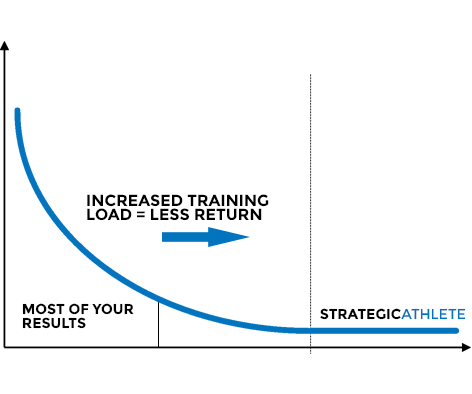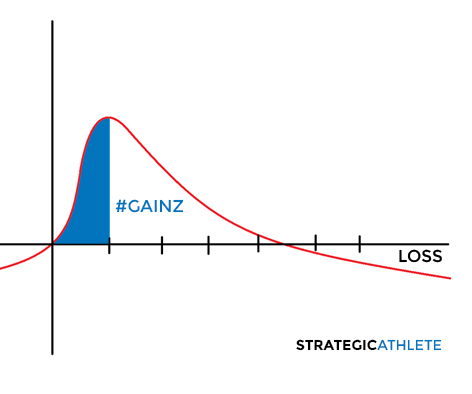The Pareto Principle, also known as the 80/20 rule, states that for many events roughly 80% of effects come from 20% of the causes.
More specifically, 80% of your results come from 20% of your efforts.
While I haven’t talked about this subject specifically it is something that has definitely been alluded to in numerous previous articles (here, here, and here) and it’s a pretty important topic because not understanding this can cause people a lot of problems.
For example, many of you know that I’m no fan of the traditional long, slow, distance style of endurance training. I’m not saying it doesn’t work, I just don’t think it is the best way to train… Especially if you’re a military or tactical athlete or just someone who would like to be fitter and healthier overall.
But, more miles is the name of the game in that style of training and because of this, you’ll quickly run into that pesky law of diminishing returns.
Check out the figure below for a quick reference on what I’m talking about.
Figure 1, Power Law (Law of Diminishing Returns)

So, this image is basically showing you that sure, you CAN run more, but the benefit (i.e. adaptation to your aerobic energy system) is going to be smaller and smaller as you continue training.
If you’re a beginner, then you can probably ignore this as you’ll make great gains no matter what. But, I’m guessing most of you have been running (even if only unit PT) for a long time now and for some reason are still not getting faster, right?
This is likely because at some point it takes a whole lot of extra training to continue making progress. This may not be a problem if you’re a professional athlete and have all day to train and recover.
Hopefully, you caught that very keyword I just mentioned in the last session: “recover”
Because if you aren’t able to properly recover then adding more training stress is actually going to make you worse.
Figure 2, Training Stress Response Curve

The area under the curve in this image is the result of overreaching or overtraining, something you’re gonna want to avoid.
This is why I try to keep my athletes in that optimal range with their training while still increasing volume, load, distance, etc and you should too.
One of the best ways to do this is to keep the training constantly varied while still working towards a singular goal.
Using running as an example, we can look at the overall weekly volume and how the athlete is performing.
A beginner might be assigned 3 running workouts in their first training week like this:
- Workout 1: 4 x 400m, recover 2:00 between efforts
- Workout 2: 2 x 800m, recover 3:00 between efforts
- Workout 3: 1 Mile Time Trial
As you can see, each of these workouts only has a total of 1 mile of running volume in them but they are all very different. Each working on a different training response and helping the athlete build speed and capacity at a number of distances.
Depending on the training age of the athlete (How experienced with the training they are) you could continue this pattern, increasing the weekly volume as much as needed, or as much as they can handle without falling apart.
While this is a very basic example it is meant to demonstrate how you could vary your training, continue to adapt in a positive manner, and overcome those plateaus without running into that diminished return or loss.
For those of you interested in losing weight, or more specifically improving your body composition by losing FAT specifically the same principles apply.
Diet & Pareto’s Principle
If we take a very simplistic few of weight loss via diet the theory goes something like:
- Eat less energy than you expend and you’ll lose weight
- Eat more energy than you expend and you’ll gain weight
This is the basic outline of the vast majority of traditional nutritionists and dietitians out there in the world, centered around the energy balance equation (calories in vs calories out) and it can be very misleading to people for a number of reasons.
Calories In
First, the calories you stuff in your mouth are not all absorbed in the body depending on a whole bunch of factors I’m not going to get into here. Additionally, nutrition labels are estimates at best, so accurately tracking calories is not only painful but imprecise.
Bottom line: The calories in portion of this energy balance equation varies from person to person and depends on that individual’s ability to absorb those calories as well as having a solid idea of that actual number of calories you’re consuming.
Calories Out
Second, again calories expended differ based on the individual. Things such as resting metabolic rate (RMR), the thermic effect of eating (TEE), your daily physical activity (PA), and any non-exercise activity thermogenesis (NEAT).
So your individual calories out equation looks more like:
Energy out = RMR + TEE + PA + NEAT
Bottom line: The calories out portion of the energy balance equation has a lot more to it than just physical activity and exercise.
So how does this all relate to that diminishing returns stuff?
Well, your body is pretty smart and it’s also designed first and foremost to survive.
So when you crash diet, or significantly reduce your calories in, your body will change to keep you functioning. Because all your body knows is that you may be stuck in the tundra with little to no food…
So when your calories get reduced, your body will reduce the energy out as well.
So TEE drops because you’re eating less
RMR drops because you weight less
NEAT goes down as you eat less
The amount of calories burned through PA is reduced because you weight less
And your body does a better job at absorbing calories.
All of these things make it harder to lose weight.
The more weight you lose, the more your body reduces these things to keep you from starving to death… Because your body doesn’t know there’s a Carl’s Jr around the corner.
And this is why more advanced athletes and bodybuilders do things like carb cycling and have strategic reseed days worked into their routine when they need to operate at a very low percentage go body fat.
Varying your diet, just like varying your training, can help to keep you in that optimal range of the curve in those figures above so that you’re constantly improving and not worrying about plateaus or losing those sweet #gainz you’ve worked so hard for.
So what does this mean to you?
More is not necessarily better, much like the title of this article states.
Sure your training load will need to increase as you become more and more trained but at a certain point increasing training is just not going to make much of a difference (or you’ll run out of time to train and won’t be able to continue increasing).
So you are much better off varying your training in a way that still helps chip away at your particular goal.
As you do this make sure you keep it simple.
There are probably a million and a half exercises out there you could be doing but a small handful of things you’ll get the most bang for your buck for (That 20% I mentioned).
This is why your training should be focused on basic barbell lifts (Squats, Deadlifts, Presses, Cleans), bodyweight movements (Pull-up, push-up, sit-up, burpees, lunges, etc), and conditioning (Sprints, loaded carries, sled push/pull, etc).
Those core movements are going to give you 80% of your results.
Additionally, keeping the reps, sets, rest, loads, and just about everything else varied in a way where you can track progress is incredibly important.
This doesn’t mean your training should be random, it shouldn’t, but you should vary your workouts while still keeping your eye on your goal.
As far as weight loss goes, if you’ve been dieting for a while and have seemed to hit a plateau that you may want to look into more advanced topics such as carb cycling. Again, varying things up and keeping your body moving in the right direction.